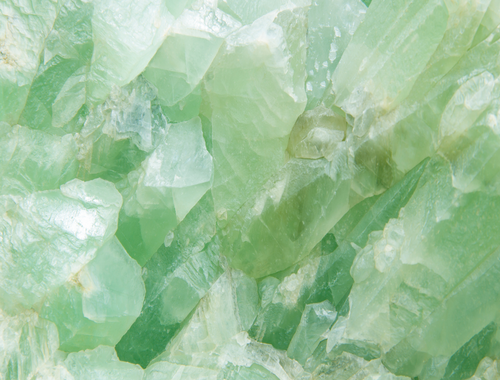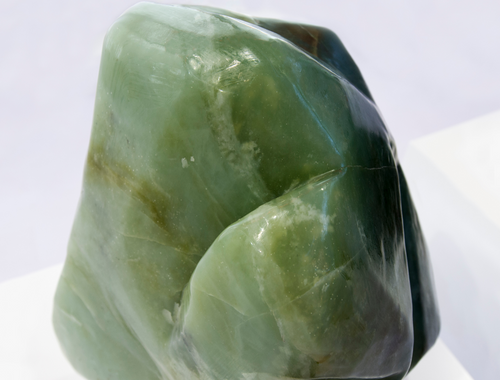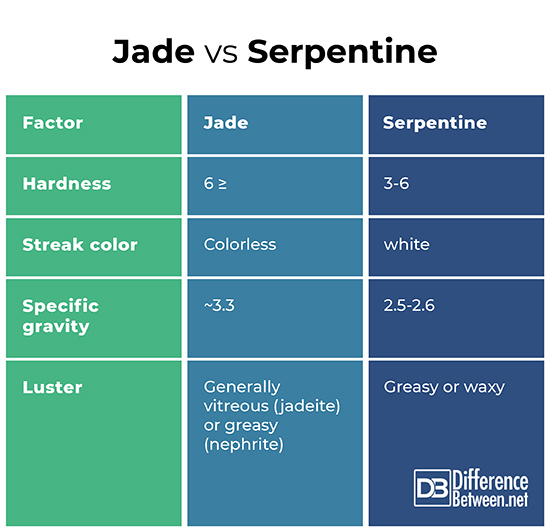Difference Between Jade and Serpentine

What is Jade?
Jade is a cultural term that is used to refer to one of two minerals which appear similar, jadeite and nephrite. Jadeite is an aluminum-rich pyroxene. It is a hard mineral (6.5-7 Mohs scale of hardness). Nephrite is a magnesium amphibole. Mineralogically, nephrite can either be tremolite or actinolite. Both minerals can range from white to dark green in color.
Jadeite and nephrite are both formed in metamorphic conditions, usually at subduction zones where crust from one tectonic plate is being thrust, or subducted, under another tectonic plate. Jadeite comes from areas subjected to higher pressure than nephrite. As a result, nephrite and jadeite deposits are geographically separated.
Both types of jade, because of their hardness, have been used for at least 100,000 years by humans for making tools, ornaments, figurines, and jewelry. Areas particularly famous for their jade artifacts include Mesoamerica and China.
Jade artifacts have been made in China for thousands of years. Jade craftsmen in China were able to distinguish between nephrite and jadeite and recognized that jadeite was harder, though the distinction was a practical one rather than a scientific one. The earliest use of jade in China included making tools and ornamental plaques bearing animal designs. Later Chinese jade artifacts include sculptures and hollow vessels, among many other utilitarian and luxury objects. The source of Chinese jade has historically been either what is now Xinjiang or modern-day Myanmar.
In Mesoamerica, jade was used primarily to make ornaments, pendants, figurines, and badges of rank, among other prestige items. The source of Mesoamerican jade was the Motagua Valley in Guatemala. The Mesoamerican jade industry died out after European colonization.
Another location famous for its jade artifacts is New Zealand. The Māori, before the arrival of Europeans, did not have any metalworking technology. They used the nephrite found on the islands to make knives, adzes, axes, and other tools. Jade was a major industrial material for the Māori. One source of jade for the Māori was fragments of nephrite from glacial outwash deposits.

What is Serpentine?
Serpentine is a class of minerals that are formed when ultramafic rocks, such as dunite and peridotite, undergo hydrothermal metamorphism, where water chemically alters pyroxene and olivine minerals into serpentine minerals, or else replaces pyroxene and olivine with serpentine minerals. Large sections of Earth’s surface are underlain by rock composed almost entirely of serpentine minerals, referred to as serpentinite. On Earth, serpentine typically forms at subduction zones where an oceanic plate, bearing ultramafic rocks, is being thrust down into the mantle. Sea water entrained in the down-going oceanic slab is the source of the water for the hydrothermal metamorphism.
Serpentine is known for its green color and translucent diaphaneity, among other characteristics. The three common species of serpentine are chrysotile, antigorite and lizardite. Chrysotile has a fibrous crystal habit, meaning that it forms in small fibers. This has made it both famous and infamous. Chrysotile is common, easy to mine and makes an effective insulator. For this reason, chrysotile was widely used as an insulator and in construction by the mid-20th century. This was before the asbestiform fibers were implicated in the cause of lung cancer, among other forms of cancer.
How valuable is serpentine?
Serpentine is a fairly soft material (Mohs scale 3-6). As a result, it is useful as a carved stone and is commonly used to make figurines and sculptures. It can also be used to make jewelry, such as earrings and pendants. The softness of some serpentine minerals limits their use to objects that will not be subject to significant wear or abrasion.
Is serpentine a rare stone?
Most serpentines other than the three common types, lizardite, antigorite, and chrysotile, are rare, but serpentine in general underlies significant areas of Earth’s surface and thus is not rare.
Similarities between jade and serpentine
Serpentine and jade are similar in that they are both known for their green color. They are also similar in that they both form at subduction zones through metamorphic processes.
Differences between jade and serpentine
Is serpentine different from jade?
Yes, despite the similarities between jade and serpentine, they are not the same mineral.
Is serpentine the same as nephrite jade?
Serpentine is not nephrite jade.
Is green serpentine jade?
Serpentine and jadeite are both known for potentially having a green color, but green serpentine is not jade.
Despite their similarities, jade and serpentine are not the same. The characteristics which distinguish them include the following.
- Jade has a hardness of 6 or greater, whereas serpentine has a hardness of 3-6.
- Jade has a colorless streak (when scratched against a porcelain tile or streak plate), whereas serpentine has a white streak.
- Jade has an average specific gravity of about 3.3, whereas serpentine has a specific gravity of 2.5-2.6.
- Jade generally has a vitreous (jadeite) or greasy (nephrite) luster, whereas serpentine has a greasy or waxy luster.
Jade vs serpentine

Summary
Jade is a hard material that is made from one of two minerals, jadeite or nephrite. Jadeite is an aluminum-rich pyroxene. Nephrite is a magnesium amphibole. Both minerals have a range of colors including green and white. Jade is formed through metamorphism at subduction zones. Because of the hardness of jade, it has been used by humans for thousands of years to make tools, weapons, ornaments, jewelry, and sculptures. Serpentine is a class of minerals known for being a distinctive green color. They are formed when ultramafic rocks undergo hydrothermal metamorphism, usually at subduction zones. Serpentine is a relatively soft material. Since it is easy to carve, it has been used to make sculptures and jewelry. It has also been used in construction to make structures that do not receive significant ware or abrasion. The three main types of serpentine minerals are chrysotile, antigorite, and lizardite. Chrysotile is asbestiform and was used widely as an insulator in buildings before it was found to be associated with lung cancer. Jade and serpentine are similar in that they are both known for their distinctive green color and are formed geologically at subduction zones. They have also both been used in making ornaments and figurines. They differ in important ways as well. Jade has a hardness of 6 or greater, a colorless streak, a specific gravity of about 3.3, and a generally vitreous (jadeite) or greasy (nephrite) luster, while serpentine has a hardness of 3-6, a white streak, a specific gravity of 2.5-2.6, and a greasy or waxy luster.
- Difference Between Environmental Performance Index and Development - November 24, 2023
- Difference Between Environmental Intervention and Development - November 8, 2023
- Difference Between Eco Efficiency and Eco Effectiveness - September 18, 2023
Search DifferenceBetween.net :
References :
[0]Britannica, The Editors of Encyclopaedia. "jade". Encyclopedia Britannica, 17 Oct. 2022, https://www.britannica.com/topic/jade-gemstone. Accessed 3 January 2023.
[1]Britannica, The Editors of Encyclopaedia. "jade". Encyclopedia Britannica, 17 Oct. 2022, https://www.britannica.com/topic/jade-gemstone. Accessed 3 January 2023.
[2]“Jade.” Mindat.org, n.d., https://www.mindat.org/min-10403.html.
[3]King, Hobart M. “Serpentine.” Geology.com, https://geology.com/minerals/serpentine.shtml. Accessed 3 January 2023.
[4]King, Hobart M. “What is Jade?” Geology.com, https://geology.com/gemstones/jade/. Accessed 3 January 2023.
[5]“Serpentine Subgroup.” Mindat.org, n.d., https://www.mindat.org/min-11135.html.
[6]Simmons, William B. "amphibole". Encyclopedia Britannica, 27 Oct. 2016, https://www.britannica.com/science/amphibole. Accessed 3 January 2023.
[7]Simmons, William B. "pyroxene". Encyclopedia Britannica, 7 Apr. 2014, https://www.britannica.com/science/pyroxene. Accessed 3 January 2023.
